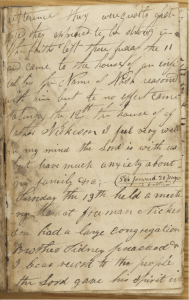Historical Context and Background of D&C 100

Video Overview
Brief Synopsis by Steven C. Harper
The adulterous apostate Doctor Philastus Hurlbut threatened to wash his hands in Joseph Smith’s blood.1 Besides that, the Saints in Missouri were in the midst of being forced from the promised land. On the bright side, missionary work around the Great Lakes was thriving. In the midst of the chaos, Joseph and Sidney accepted the invitations from prospective converts and referrals from friends and relatives and went on a mission through Pennsylvania to upstate New York and Ontario, Canada.
On October 12, 1833, Joseph did something he rarely did. He wrote his own journal entry, or at least part of it. “I feel very well in my mind,” it says in his handwriting, “the Lord is with us but have been much anxiety about my family.”2 The Lord was with them and gave Joseph section 100 that day. It addresses Joseph’s mission with Sidney Rigdon and the two concerns that occupied his anxious mind: Zion and the safety of his family and other Saints.3 The revelation begins with the Lord’s omnipotent assurance that Joseph’s and Sidney’s families are well: “They are in mine hands, and I will do with them as seemeth me good” (D&C 100:1).
About the mission, the Lord gives Joseph and Sidney specific, omniscient counsel that could guarantee their success, depending on how they decide to act on the counsel. If Joseph and Sidney speak the thoughts the Lord puts into their hearts, he says, they will not be confounded. If they solemnly, meekly declare the gospel in the Lord’s name, He promises that the Holy Ghost will testify of their words. He promises Joseph a powerful testimony and Sidney the ability to expound scripture. He makes Joseph a revelator for Sidney and Sidney a spokesman for Joseph.
Beginning in verse 13, the Lord offers “a word concerning Zion.” He promises protection and salvation to the brethren Joseph sent to Missouri with messages. “Zion shall be redeemed,” the Lord promised, after she is chastened and becomes pure and willing to serve the Lord.
Joseph Smith possessed a dogged tenacity. He did not want to give up on Zion, on New Jerusalem being built around a holy temple in Jackson County, Missouri. Oliver Cowdery had recently suggested that the Saints could start over somewhere else. Joseph resisted that thought. He told the Saints in Missouri that the Lord wanted them to hold onto their land, not sell it, not give up on Zion. He promised them that Zion would flourish in spite of hell, though he did not pretend to know how or when.
Joseph described himself as praying fervently and often in the past weeks after Zion had been beaten. He could not understand why. He even said that he murmured about it. Section 100 comforted Joseph. It reinforced his faith in Zion, though it did not answer his questions about how or when the Lord would put the Saints back in the promised land. Joseph wrote that based on section 100,
I know that Zion, in the own due time of the Lord will be redeemed, but how many will be the days of her purification, tribulation and affliction, the Lord has kept hid from my eyes; and when I enquire concerning this subject the voice of the Lord is, Be still, and know that I am God! all those who suffer for my name shall reign with me, and he that layeth down his life for my sake shall find it again.4
Section 100 eased Joseph’s anxieties about his family’s safety in the hostile environment of Kirtland, Ohio. On returning from his month-long mission, he dictated the following journal entry: “Found my family all well according to the promise of the Lord for which blessings I feel to thank his holy name.”5
1. “Letter to Church Leaders in Jackson County, Missouri, 18 August 1833,” p. [1], The Joseph Smith Papers, accessed September 9, 2020.
2. “Journal, 1832–1834,” p. 7, The Joseph Smith Papers, accessed September 9, 2020.
3. “Revelation, 12 October 1833 [D&C 100],” p. [1], The Joseph Smith Papers, accessed September 9, 2020.
4. “Letter to Church Leaders in Jackson County, Missouri, 18 August 1833,” p. [1], The Joseph Smith Papers, accessed September 9, 2020.
5. “Journal, 1832–1834,” p. 18, The Joseph Smith Papers, accessed September 9, 2020.
Additional Context by Casey Paul Griffiths
From Doctrine and Covenants Minute
In spite of the challenges facing the Church in Missouri and in Ohio, missionary efforts continued, and the Church grew. In September 1833, Freeman and Huldah Nickerson, new converts of just a few months, visited Joseph Smith and Sidney Rigdon in Kirtland and invited them to travel to Perrysburg, New York, to preach to several of their relatives. Perrysburg was a week’s journey away from Kirtland, and Joseph began to feel anxiety over leaving his family. His feelings might have been caused by Doctor Philastus Hurlbut, an excommunicated member of the Church who was stirring up opposition to the Church in the Kirtland area. In a journal entry written a few weeks after Hurlbut’s excommunication Joseph wrote that after being cut off from the Church, Hurlbut “then sought the destruction of the saints in this place [Kirtland] and more particularly myself and family.”1
Upon arriving in Perrysburg, Joseph wrote in his journal, “I feel very well in my mind the Lord is with us but [I] have much anxiety about my family.”2 From the context of Doctrine and Covenants 100 it is clear that Joseph and Sidney were also deeply worried over the trials faced by the Saints in Missouri. The Lord addressed all of these concerns and gave them additional instructions in this revelation.
See “Historical Introduction,” Revelation, 12 October 1833 [D&C 100]
1. JS Journal, 1832–1834, p. 50, JSP.
2. JS Journal 1832–1834, 6–12 October 1833, p. 7, JSP.
